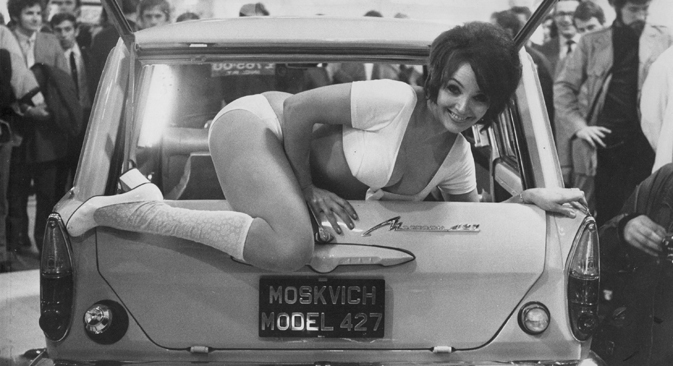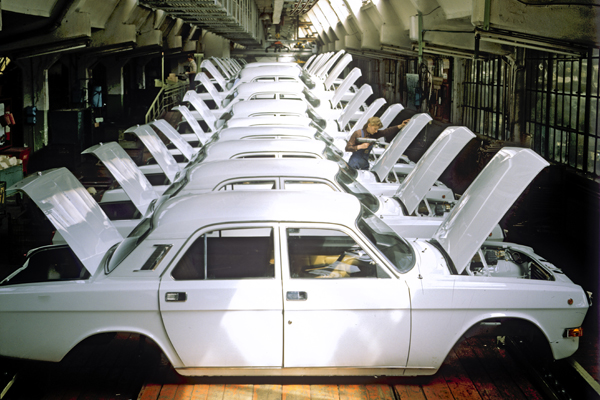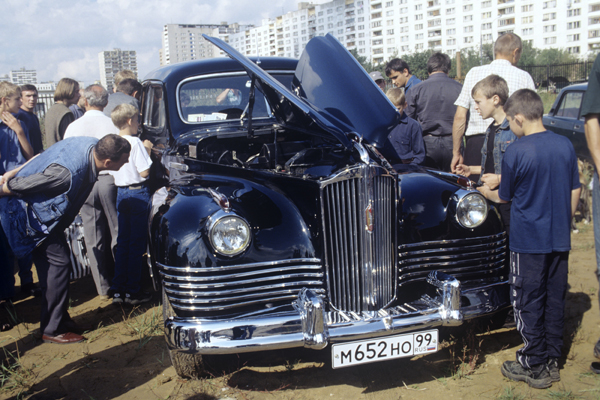
Model Julie Desmond climbs out of the back of a Moskvich 427 at a trade show, circa 1971
Getty ImagesA strong, powerful vehicle that could hold up well to wear and tear, the Studebaker truck had everything the Soviet Union needed during World War II. It was one of the most popular vehicles supplied by the U.S. under the Lend-Lease program. After the war, the Soviet troops who rode in Studebakers to the battlefield remembered some of the truck’s best attributes. The trademark Studebaker long hood can be seen in many Soviet truck models produced after the war.
These features were not just the result of reverse engineering, however. Ford first came to imperial Russia in the early 20th century and returned to the Soviet Union in the 1930s to help with the construction of a car factory — the Gorky Automobile Plant, or GAZ. Many of the trucks produced there were almost exact replicas of Ford A and Ford A A trucks, called GAZ-A and GAZ-AA. Even though Ford’s cooperation with the Soviets ended during the Great Depression, there were still traces of American design in Soviet car production.
“The vehicles themselves were derivatives of models designed in Detroit and elsewhere in the West, but adjusted for the Soviet climatic and road conditions,” wrote historian Lewis H. Siegelbaum in “Cars for Comrades: The Life of the Soviet Automobile”, published in 2008. “They included what once had been basic lines in Ford’s repertoire, luxury limousines from General Motors and Packard.”
 Cars go through a final check at the GAZ factory, 1986. Source: S. Lidov / RIA Novosti
Cars go through a final check at the GAZ factory, 1986. Source: S. Lidov / RIA Novosti
The first Soviet limousine used by high-ranking Communist officials had its roots in the 1932 Buick. The car was made by another Soviet automobile factory known as ZIS, the Russian acronym for Zavod imeni Stalina, or the Stalin Factory.
The Soviet dictator was fond of American cars, which were known for being both well-built and stylish. The U.S.-made Packard was Stalin’s favorite, and he had several models, including a brand-new Packard 12, presented to him by U.S. President Franklin Roosevelt. One of the Packard models from 1942 was used as an inspiration for the ZIS 110, the first Soviet limosine produced after the war. Stalin personally commissioned the car’s design.
Although many Soviet automotive engineers were afraid of moving too far from Stalin’s preferences, top car designer Andrei Ostrovtsov incorporated elements of other American models to create the ZIS 110. He considered the Packard an outdated model and took his inspiration from Buick and Cadillac. The car became the favorite automobile of the Communist party elite.
The Packard also inspired the design of the other car popular among the party bosses, the GAZ 13 Chaika, or seagull. The car’s hood and front lights gave the impression of wings. This car was a favorite of Soviet leaders from Leonid Brezhnev to Mikhail Gorbachev. Ordinary citizens, resentful of having to wait years to be eligible to buy a cheap Lada model while the elites were driven around in the height of style, mocked the Chaika, and called it the “chlenovoz” literally the “member carrier.”
Eventually even regular Soviets had a chance to own an American-inspired vehicle. Mass production of cars began during the tenure of the post-Stalin reformer Nikita Khrushchev.
American businessman Frank Orban believes that Khrushchev’s 1959 visit to the United States inspired him to launch the program. “Khrushchev came to the U.S. and learned that the auto industry, which was small in the U.S.S.R., was in fact a major economic engine that developed other industries and created advanced infrastructures. “In particular, road systems,” said Orban, who once sold Soviet cars in the West.
 People get up close with a ZIS 110 at a parade of retro cars, 2000. Source: Yuri Abramochkin / RIA Novosti
People get up close with a ZIS 110 at a parade of retro cars, 2000. Source: Yuri Abramochkin / RIA Novosti
In 1956, the GAZ factory produced its trademark Volga 21, an elegant car whose front resembled the face of a shark. The car took its inspiration from a 1953 Ford and the Mercury Monterey produced in the same year.
The Mercury was used as a police cruiser in the U.S. at the time, and the Volga 21 was also the car of choice for police and emergency vehicles. It was the most popular car of the Soviet middle class.
A Volga 21 in good condition is still a popular car among collectors. Comedian Jay Leno, known for his love of classic cars, owns a 1966 model. “The Volga isn’t particularly well-made, but it’s very strong, like bull,” he told Popular Mechanics magazine in 2013.
Several years ago, Pyotr Voronkov, who hosts the Ekipazh radio program about cars on Stolitsa FM, was in an accident involving his Volkswagen Tiguan and a Volga 21. “The Volga driver touched me only briefly with his right part, but the upper part of my car cracked like a Champagne glass on the frost, leaving only a small scratch on Volga,” Voronkov said.
Russian President Vladimir Putin took U.S. President George W. Bush for a ride in his Volga when the American leader visited Russia in 2005.
At that time, Putin even offered to let Bush drive the white car himself: “He’s giving me a driving lesson,” Bush said jokingly. He might have taken Putin up on the offer had he known about the car’s American roots.
“They were brutal, powerful forms of art,” radio host Voronkov said of the classic American cars. “Today many cars are more comfortable, but they look almost the same.”
All rights reserved by Rossiyskaya Gazeta.
Subscribe
to our newsletter!
Get the week's best stories straight to your inbox